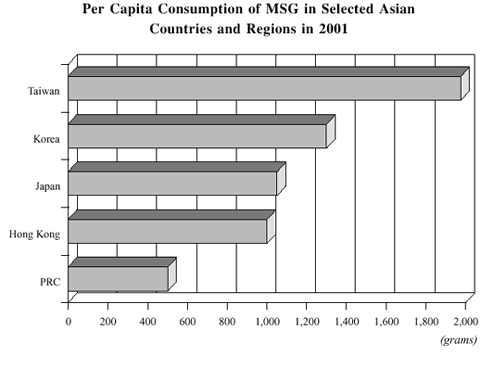 |
 |
 |

|

 |

- AMINO
ACIDS PRODUCT INDUSTRY
Overview of the global amino acids industry
MSG is an amino acids product which is made through the
use of fermentation technology. The fermentation technology
can be used in the production of the following principal
product categories: alcoholic industry; amino acids; antibiotics;
enzymes and vitamins. Efficiency of all fermentation processes
depend on the efficient utilisation of carbohydrates which
are supplied mainly in the form of glucose and molasses.
It is therefore the availability and the pricing of these
raw materials that influence the cost competitiveness
of the fermentation products.
The directors believe the amino acids product industry
is characterised by high barriers to entry due to the
following requirements: (i) capital intensity; (ii) technical
knowledge and expertise; (iii) access to abundant and
low cost supply of raw materials; (iv) recognised brand
name and established sales and distribution network; and
(v) economies of scale. As a result, for example, the
global MSG industry and the lysine industry, which are
part of the amino acids product industry, are dominated
by a few leading players in the world.
General information
The amino acids product category is dominated by two products,
namely MSG and lysine, which are widely used in food flavour
enhancing products, pharmaceutical, animal feed and several
other industries. Hence, the overall market size for amino
acids products is influenced by numerous factors, ranging
from general economic and demographic patterns to specific
societal, regulatory and technological trends affecting
the production and consumption of various end-use products.
Amongst others, the global food and agricultural industries
play a critical role in shaping the amino acids market.
The food industry is most relevant due to the position
of GA ¡X primarily in the form of MSG ¡X as the major amino
acids product by value and by volume. Agriculture is an
important consideration because animal feed is the second
largest market for the principal use of lysine.
Global MSG
industry
MSG is commonly used as a flavour enhancing product.
The U.S. Food and Drug Administration categorised MSG
as ''generally recognised as safe'', or ''GRAS'', along
with other common food ingredients, such as salt, vinegar
and baking power. It was first reported in 1968 that
a complex of symptoms occurred following ingestion of
Chinese meal that was allegedly contained MSG. Such
symptoms consisted of numbness at the back of the neck
gradually radiating to the arms and the back, general
weakness, chest pain and palpitations. MSG, along with
cooking wine and high sodium in food, was proposed to
trigger these symptoms that are collectively referred
to as ''Chinese restaurant syndrome''. In response to
these allegations, safety evaluations of MSG were conducted
by a joint expert committee of the Food and Agriculture
Organisation of the United Nations and the World Health
Organisation on food additives in 1971 and 1974. The
same committee also conducted a more comprehensive safety
evaluation in 1987. In addition, the Scientific Committee
for Food of the Commission (''SCF'') of the European
Communities reviewed the then available scientific data
on the use of MSG in 1991, which was followed by a comprehensive
review by the Federation of American Societies for Experimental
Biology (''FASEB'') in 1995 on the reported adverse
reactions following consumption of MSG.
The Directors are of the view that the above studies
concluded no scientific evidence to support the allegation
that MSG was the casual agent in provoking the full
range of the Chinese restaurant syndrome. There was
no unequivocal relationship between ''Chinese restaurant
syndrome'' and consumption of MSG. The SCF reached a
similar conclusion and suggested that there is no need
to specify the acceptable daily intake level. FASEB
also found that there was no scientific evidence linking
MSG to any serious long-term medical problems in the
general population.
The Directors consider that household use of MSG is
common in developing countries, such as Vietnam, the
ASEAN countries, the PRC and Indonesia, whereas MSG
is also generally used in food service sectors, such
as restaurants and food producers, in developed countries.
Amongst the Asian countries and territories, the PRC
is one of the major importers of MSG products, and Vietnam,
Thailand, Taiwan and Indonesia are the major exporters
of MSG products.
The Directors believe that the consumption of MSG products
in the PRC will continue to increase with the continuous
improvements in living standards. The following diagram
illustrates the per capita consumption of MSG products
in certain selected Asian countries and regions in 2001:¡X
 Source:China Fermentation Association
Source:China Fermentation Association
In addition to its dominance in Asia, MSG is also one
of the leading flavour enhancing products in most industrialised
regions because it is inexpensive and can provide a
distinctive flavour. For example, the U.S. and the Netherlands
are amongst the major importers of MSG, and these countries
are characterised by growing popularity of ethnic cuisines
where MSG is prevalent, and by an increasing number
of Asian immigrants who prefer to use food flavour enhancing
products as part of their diet.
Global
lysine industry
Lysine will continue to appeal to livestock
farmers for agronomic reasons, particularly as a cost
effective additive to soybean feed. In addition, lysine
offers farmers opportunities to reduce manure generation
whilst increases flexibility in feed formulation, neither
of which is available with conventional soybean feed
sources.
In other applications, lysine used as a nutritive agent
in human dietary supplements, in certain baking products
and as a research reagent; lysine is also used as a
flavour mask for offsetting the metallic taste of potassium
chloride in salt substitutes. However these products
command relatively little of lysine volume vis-a`-vis
livestock feed.
- INTRODUCTION
- STARCH-BASED
INDUSTRY
- SPECIALTY
CHEMICAL PRODUCT INDUSTRY
- BEVERAGES
PRODUCT INDUSTRY
|
| |

|
|
